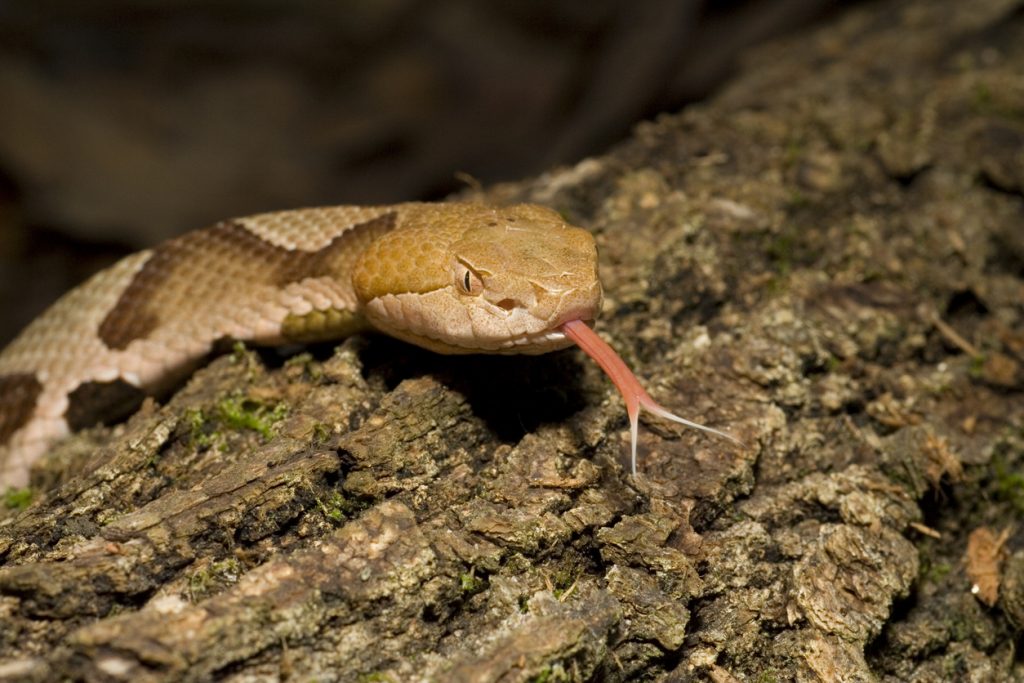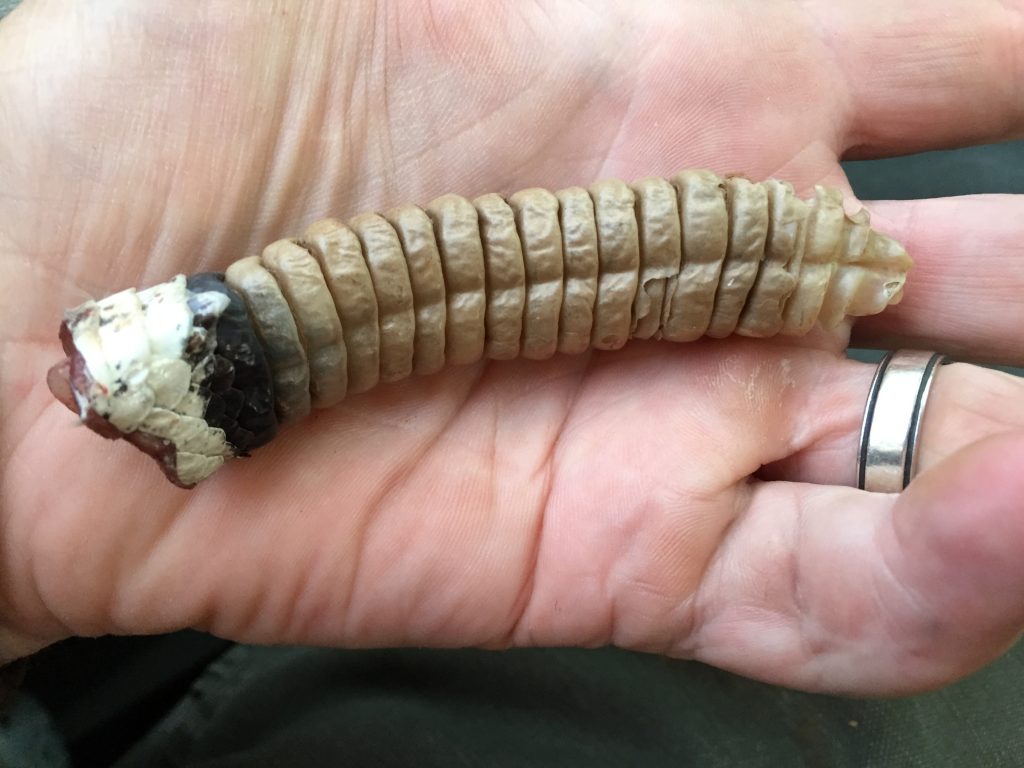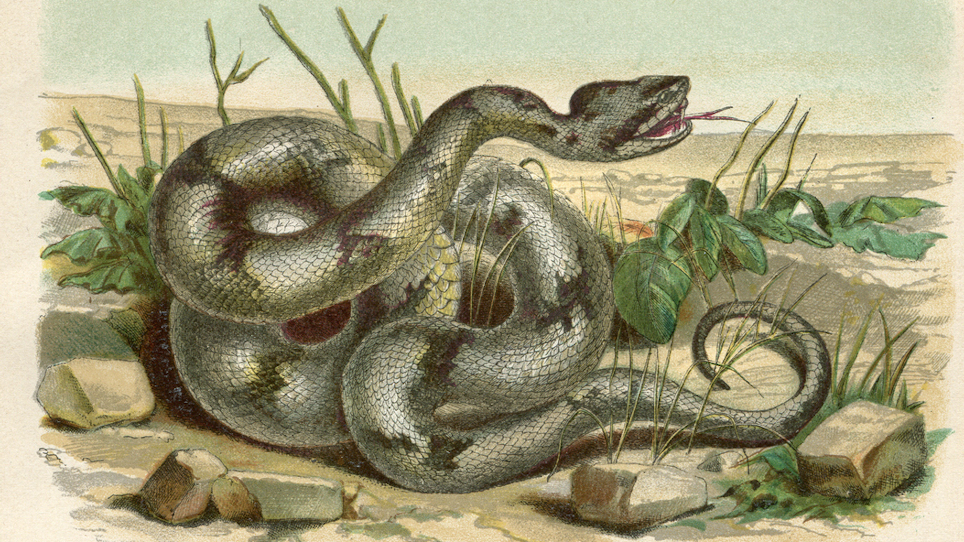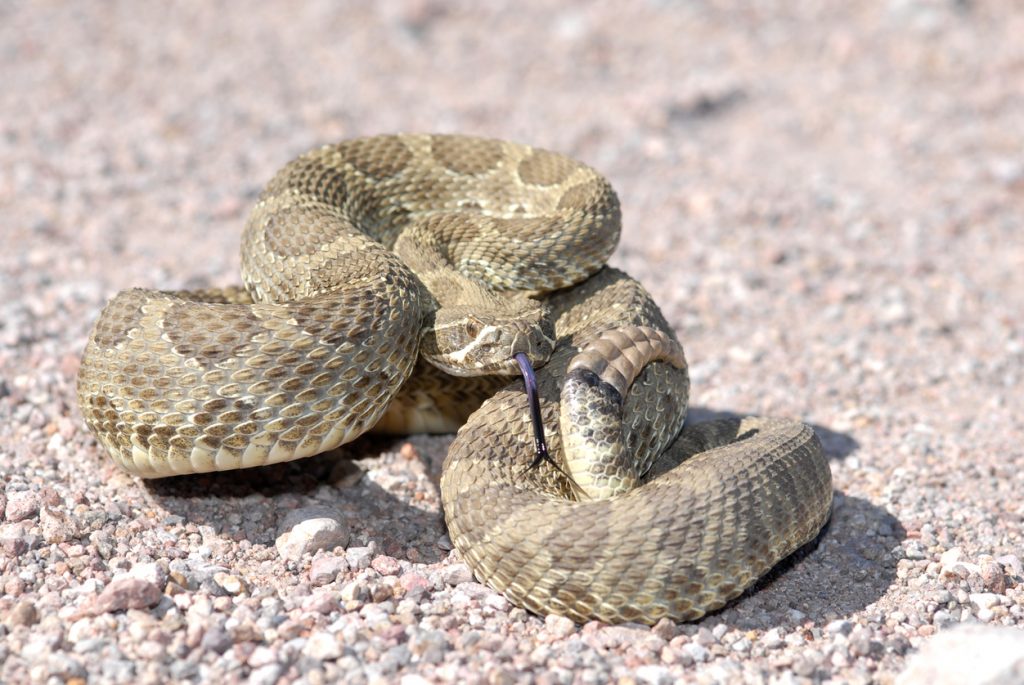Like the venerable Dr. Indiana Jones, not many things in life spook me — but snakes do. Not sure why, they just do. Growing up in the southwest, I have had my share of rattlesnake encounters. During a few turkey and deer hunts in the southeast, I got a taste of cottonmouths and coral snakes, too. Even saw a couple of bad actors — notably the black mamba and puff adder — in Africa, but even “good” snakes like king snakes and gopher snakes give me the heebie-jeebies.
Interestingly, making this list isn’t that hard. There are just 21 species of venomous snakes in the United States, according to the Society for the Study of Amphibians and Reptiles. Nearly two-thirds of these are true rattlesnakes (Crotalus) along with one, Sistrurus miliarius, more commonly called the pygmy rattlesnake.
Did you know that, globally, it is estimated there are millions of snake bites annually, with well over 100,000 snake-bite related deaths? In the U.S. the exact number of snake bites isn’t known, but estimates place them between 1,000 to 2,000, with deaths averaging less than the fingers on two hands. And nowadays, excellent anti-venom is readily available in most regions.
With hot weather approaching, snakes are sure to pop out. Isn’t that comforting? Here are the Top 10 most venomous snakes in North America.
10) Yellowbelly Sea Snake
(Pelamis platura)
The yellowbelly sea snake is not exclusive to North America, and there have been no known fatalities in the U.S. from its bite. However, its venom is highly potent with potentially human-lethal doses as small as .067 mg and the average bite delivering as much as 4.0 mg. This snake prefers warm oceans, frequenting the Pacific from Washington State down into South America and inhabits virtually all warmer waters through the Pacific and Indian oceans. The yellowbelly rarely comes ashore and will not venture into fresh water; it feeds almost exclusively on fish. The most effective anti-venoms are produced in Australia.
9) Tiger Rattlesnake
(Crotalus tigris)
Named for its pattern of vertical stripes, it also has the smallest head of any rattlesnake — but it has incredibly potent venom that, by toxicity, is considered the most dangerous of all snakes in the Western Hemisphere. The tiger only lives in a small area near the Arizona-Mexico border and few bites have been documented. The small amount of venom it injects per bite means that fatalities are very rare.
Related: The Truth About Rattlesnakes
8) Massasauga Rattlesnake
(Sistrurus catenatus)
Also known as the black rattlesnake, it is most common in Ontario and Michigan and through the upper Missouri valley with small populations reported in Colorado and ranging down to Mexico. It rarely exceeds 24 inches with large specimens topping out at 30 inches. Their venom is moderately toxic. Bite treatment is generally with “generic” rattlesnake antivenin. No fatalities have been reported among those getting treatment. Although over the past few decades, there are multiple instances of untreated bites resulting in human death. This snake prefers marsh and grasslands and is rarely seen on mountainous terrain above 1,500 feet.
7) Copperhead
(Agkistrodon contortrix)
Most copperheads are less than 36 inches long, with some reaching 48 inches. A copperhead’s venom is relatively mild and very rarely fatal. Its primary range is along the Eastern Seaboard as far north as New York and inland as far west as Nebraska. Copperheads are mostly considered non-aggressive. When excited, it often assumes a “don’t move” strategy while using its excellent camouflage to remain undetected. All pit vipers are capable of delivering a bite with little or no venom produced, but the copperhead is unique in that most defensive first strikes include no venom. If the snake is still being threatened, a second strike almost always does include venom.

Copperheads often go undetected by remaining perfectly still when they feel threatened. (Photo: iStock)
6) Coral Snake
(Eastern: Micrurus fulvius, and Western: Micruroides euryxanthus)
These two snakes both have some of the most potent neurotoxic venom in North America. Both are brightly colored with primary black and red stripes along with smaller, yellow stripes encircling the body. These two subspecies prefer the southern part of North America. The good news? Both are primarily nocturnal, lessening the chance of a fatal encounter. The Eastern is slightly larger, with captive specimens reaching nearly 40 inches while typical wild specimens are between 24 to 30 inches long.
The Western coral snake is approximately 24 inches long, but can exceed 30 inches. However, there currently is no effective antivenin, the last commercially-made product being discontinued in 2010 due to economic factors. Thus, fatality rates are estimated to be as high as 20 percent, but coral snakes are unable to release their venom fully in a single strike. It is estimated that 40 percent of the bites (about 100/year in North America) to humans contain no, or very little, venom. If you are bitten, hospitalization is highly recommended. Symptoms can be delayed by as much as a day, but progression can be extremely rapid. A typical coral snake carries approximately enough venom to kill four full-grown adults and the amount required to severely injure or kill a person is only 4 to 5 mg.
5) Cottonmouth
(Agkistrodon contortrix)
Also known as the water moccasin, its bite is much more dangerous than the bite of the closely-related copperhead, but rarely fatal. The cottonmouth is more aggressive, but as with the copperhead, biting isn’t common unless the snake is actually touched. The cottonmouth has an aggressive reputation, and when threatened, will occasionally hiss and almost always assume a strike-ready pose. The very white interior of the cottonmouth’s mouth and the snake’s habit of opening its mouth extremely wide in warning provides the common name. It reaches lengths of 72 inches, with the average a bit more than three feet.
The cottonmouth has slightly more powerful venom than a copperhead, but is still rarely lethal to humans. The biggest difference between the cottonmouth and the copperhead is that cottonmouth snakes are semi-aquatic and are most commonly found in marsh, swamp and warmer streams and lakes. The cottonmouth is the only semi-aquatic viper in the world. They have been seen in saltwater and have colonized some near offshore islands on the east coast.
4) Mojave Rattlesnake
(Crotalus scutulatus)
Shading towards a greenish hue — hence the nickname “Mojave Green” — this guy has the most toxic venom of all the rattlesnakes and a reputation I can personally attest to as extremely aggressive. Limited to the southern areas of Arizona, California, Utah, New Mexico and parts of Texas, the Mojave rattlesnake prefers open areas of sparse vegetation and sandy, desert conditions. It can reach nearly 4 feet long, but averages less than 36 inches and has a relatively stout body. Mojave rattlesnake venom is considered more toxic than even Australia’s famed tiger snake. Because bites often bleed little and cause little initial distress, it isn’t uncommon for people that have been bitten to underestimate the danger. The combination neurotoxins can cause massive negative effects that only become obvious as long as 24 hours after the bite.
3) Timber Rattlesnake
(Crotalus horridus)
Living in the densely-populated northeastern United States, this is the snake that graces the famous Gadsden “DON’T TREAD ON ME” flag. They can grow to more than 5 feet long with the largest recorded at a few inches beyond 6 feet. Large specimens can weigh nearly 10 pounds and average adults will be near 40 inches. Timber rattlers can deliver a lot of venom in a single, quick bite. With their large size, extremely long fangs and the ability to deliver massive doses, a timber rattlesnake bite should be considered life-threatening.
Related: A Reader Survives Monster Rattler
2) Western Diamondback Rattlesnake
(Crotalus atrox)
The Western diamondback has a massive range, extending well into Mexico and stretching from the Southeast to California and approximately halfway to Canada. Although the venom is somewhat less toxic than some other rattlesnakes, it makes up for it by producing immense quantities; as much as 800 mg can be delivered in a full envenomation — which is rare. The venom causes severe muscle deterioration and massive internal bleeding. Fatality rates are estimated at 20 percent.
The Western diamondback only trails its Eastern cousin (slightly) in U.S. annual fatalities and would certainly be the leading killer if its habitat were less sparsely settled by humans. Western diamondbacks are easily the snake most responsible for venomous snakebite deaths in Mexico. It is also the most aggressive of the rattlers and can grow up to 7 feet and 15 pounds, but typical specimens are in the 4-to-5-foot range and weigh less than 10 pounds. Preferred habitat is diverse, but sandy, sun-warmed desert, salt marshes and rocky mountain areas are prime locations.

The Western Diamondback is the most aggressive of the rattlers and can grow up to 7 feet and 15 pounds. Photo: Bob Robb
1) Eastern Diamondback Rattlesnake
(Crotalus adamanteus)
This behemoth is the biggest venomous snake in the Americas, with documented lengths nearing 8 feet and weights in excess of 35 pounds. Quite dangerous to humans, the fatality rate is 10 to 20 percent. It mostly eats rabbits. Like most rattlesnakes, its venom is highly hemorrhagic and contains some peptides that can cause cardiac problems leading to death. The Eastern diamondback sports massive fangs that can approach a full inch long and can pump as much as 450 mg of venom (less than 150 mg can kill a human) in a single bite. Pine forest, mountain, dry marsh and coastal areas of Florida and the lower southeastern U.S. are its prime habitat. Aside from its size, its well-defined, black-diamond patterns with yellow borders help identify this snake. Strike distance can be nearly a third of the snake’s length.
BONUS: If You're Bitten By A Venomous Snake...
First off, do not try and capture the snake — this almost always results in another bite. The doctor does not need the snake. However they do want a good description of it. Really, all you have to tell them was it was a rattlesnake or a coral snake.
Once bitten, get to a doctor or hospital as quickly as possible. Duh! Go fast, even if you are having little or no immediate distress. Many venom effects are delayed. Waiting until they appear makes treatment more difficult. Don’t be a Boy Scout and incise and suck the blood/venom out or allow anyone else to do so. This is both ineffective and dangerous to both the victim and the person trying to be helpful. If it takes a while to get to medical help, elevate the bitten area. But, most importantly, haul your buns to the hospital. There are virtually no first-aid remedies that are effective.
Finally, stay as calm as you can. Treatment for snake bites is very effective and few people die if they seek treatment immediately. Just go to your happy place and think of the stories you’ll be able to tell your friends when it’s all over and done with.
Featured image: 1881 Timber Rattlesnake engraving (Credit: iStock)







